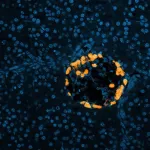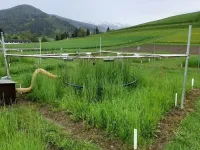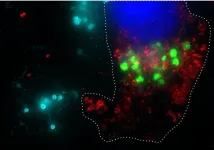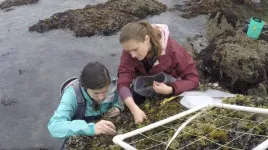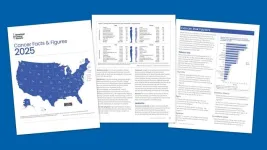(Press-News.org) Increasingly common since 1980, persistent multi-year droughts will continue to advance with the warming climate, warns a study from the Swiss Federal Institute for Forest, Snow, and Landscape Research (WSL), with Professor Francesca Pellicciotti from the Institute of Science and Technology Austria (ISTA) participating. This publicly available forty-year global quantitative inventory, now published in Science, seeks to inform policy regarding the environmental impact of human-induced climate change. It also detected previously ‘overlooked’ events.
Fifteen years of a persistent, devastating megadrought—the longest lasting in a thousand years—have nearly dried out Chile’s water reserves, even affecting the country’s vital mining output. This is but one blatant example of how the warming climate is causing multi-year droughts and acute water crises in vulnerable regions around the globe. However, droughts tend only to be noticed when they damage agriculture or visibly affect forests. Thus, some pressing questions arise: Can we consistently identify extreme multi-year droughts and examine their impacts on ecosystems? And what can we learn from the drought patterns of the past forty years?
To answer these questions, researchers from the Swiss Federal Institute for Forest, Snow, and Landscape Research (WSL) and the Institute of Science and Technology Austria (ISTA) have analyzed global meteorological data and modeled droughts between 1980 and 2018. They demonstrated a worrying increase in multi-year droughts that became longer, more frequent, and more extreme, covering more land. “Each year since 1980, drought-stricken areas have spread by an additional fifty thousand square kilometers on average—that’s roughly the area of Slovakia, or the US states of Vermont and New Hampshire put together—, causing enormous damage to ecosystems, agriculture, and energy production,” says ISTA Professor Francesca Pellicciotti, the Principal Investigator of the WSL-funded EMERGE Project, under which the present study was conducted. The team aims to unveil the possible long-lasting effects of persistent droughts around the globe and help inform policy preparing for more frequent and severe future megadroughts.
Unveiling extreme droughts that flew under the radar
The international team used the CHELSA climate data prepared by WSL Senior Researcher and study author Dirk Karger, which goes back to 1979. They calculated anomalies in rainfall and evapotranspiration—water evaporation from soil and plants—and their impact on natural ecosystems worldwide. This allowed them to determine the occurrence of multi-year droughts both in well-studied and less accessible regions of the planet, especially in areas like tropical forests and the Andes, where little observational data is available. “Our method not only mapped well-documented droughts but also shed light on extreme droughts that flew under the radar, such as the one that affected the Congo rainforest from 2010 to 2018,” says Karger. This discrepancy is likely due to how forests in various climate regions respond to drought episodes. “While temperate grasslands have been most affected in the past forty years, boreal and tropical forests appeared to withstand drought more effectively and even displayed paradoxical effects during the onset of drought.” But how long can these forests resist the harsh blow of climate change?
Contrasting impacts on ecosystems
The persistently rising temperatures, extended droughts, and higher evapotranspiration ultimately lead to dryer and browner ecosystems, despite also causing heavier precipitation episodes. Thus, scientists can use satellite images to monitor the effect of drought by tracking changes in vegetation greenness over time. While this analysis works well for temperate grasslands, the changes in greenness cannot be tracked as easily over dense tropical forest canopies, leading to underestimated effects of drought in such areas. Thus, to ensure consistent results worldwide, the team developed a multistep analysis that better resolves the changes in high-leaf regions and ranked the droughts by their severity since 1980. Unsurprisingly, they showed that megadroughts had the highest immediate impact on temperate grasslands. ‘Hotspot’ regions included the western USA, central and eastern Mongolia, and particularly southeastern Australia, where the data overlapped with two well-documented multi-year ecological droughts. On the other hand, the team shed additional light on the paradoxical effects observed in the tropical and boreal forests. While tropical forests can offset the expected effects of drought as long as they have enough water reserves to buffer the decrease in rainfall, boreal forests and tundra react in their distinct way. It turns out that the warming climate extends the boreal growth season since vegetation growth in these regions is limited by lower temperatures rather than water availability.
Droughts evolve in time and space
The results show that the trend of intensifying megadroughts is clear: The team generated the first global—and globally consistent—picture of megadroughts and their impact on vegetation at high resolution. However, the long-term effects on the planet and its ecosystems remain largely unknown. Meanwhile, the data already agrees with the observed widely greening pan-Arctic. “But in the event of long-term extreme water shortages, trees in tropical and boreal regions can die, leading to long-lasting damage to these ecosystems. Especially, the boreal vegetation will likely take the longest to recover from such a climate disaster,” says Karger. Pellicciotti hopes the team’s result will help change our perception of droughts and how to prepare for them: “Currently, mitigation strategies largely consider droughts as yearly or seasonal events, which stands in stark contrast to the longer and more severe megadroughts we will face in the future,” she says. “We hope that the publicly available inventory of droughts we are putting out will help orient policymakers toward more realistic preparation and prevention measures.” As a glaciologist, Pellicciotti also seeks to examine the effects of megadroughts in the mountains and how glaciers can buffer them. She leads a collaborative project titled “MegaWat—Megadroughts in the Water Towers of Europe—From Process Understanding to Strategies for Management and Adaptation.”
-
Project and funding information
The present study was conducted within the scope of the EMERGE Project of the Swiss Federal Institute for Forest, Snow, and Landscape Research (WSL) with Professor Francesca Pellicciotti from the Institute of Science and Technology Austria (ISTA) serving as its Principal Investigator. The research was supported by funding from the Extreme Program of the WSL for the EMERGE project.
END
The megadroughts are upon us
Forty-year study: Extreme droughts will become more frequent, severe, and extensive
2025-01-16
ELSE PRESS RELEASES FROM THIS DATE:
Eavesdropping on organs: Immune system controls blood sugar levels
2025-01-16
When we think about the immune system, we usually associate it with fighting infections. However, a study published in Science by the Champalimaud Foundation reveals a surprising new role. During periods of low energy—such as intermittent fasting or exercise—immune cells step in to regulate blood sugar levels, acting as the “postman” in a previously unknown three-way conversation between the nervous, immune and hormonal systems. These findings open up new approaches for managing conditions like diabetes, obesity, and cancer.
Rethinking the Immune ...
Quantum engineers ‘squeeze’ laser frequency combs to make more sensitive gas sensors
2025-01-16
The trick to creating a better quantum sensor? Just give it a little squeeze.
For the first time ever, scientists have used a technique called “quantum squeezing” to improve the gas sensing performance of devices known as optical frequency comb lasers. These ultra-precise sensors are like fingerprint scanners for molecules of gas. Scientists have used them to spot methane leaks in the air above oil and gas operations and signs of COVID-19 infections in breath samples from humans.
Now, in a series of lab experiments, researchers have laid out a path for making those kinds of measurements even more sensitive and faster—doubling the speed of ...
New study reveals how climate change may alter hydrology of grassland ecosystems
2025-01-16
New research co-led by the University of Maryland reveals that drought and increased temperatures in a CO2-rich climate can dramatically alter how grasslands use and move water. The study provides the first experimental demonstration of the potential impacts of climate change on water movement through grassland ecosystems, which make up nearly 40% of Earth’s land area and play a critical role in Earth’s water cycle. The study appears in the January 17, 2025, issue of the journal Science.
“If we want to predict the effects of climate change ...
Polymer research shows potential replacement for common superglues with a reusable and biodegradable alternative
2025-01-16
EMBARGO: THIST CONTENT IS UNDER EMBARGO UNTIL 2 PM U.S. EASTERN STANDARD TIME ON JANUARY 16, 2025. INTERESTED MEDIA MAY RECIVE A PREVIEW COPY OF THE JOURNAL ARTICLE IN ADVANCE OF THAT DATE OR CONDUCT INTERVIEWS, BUT THE INFORMATION MAY NOT BE PUBLISHED, BROADCAST, OR POSTED ONLINE UNTIL AFTER THE RELEASE WINDOW.
Researchers at Colorado State University and their partners have developed an adhesive polymer that is stronger than current commercially available options while also being biodegradable ...
Research team receives $1.5 million to study neurological disorders linked to long COVID
2025-01-16
The National Institute of Mental Health has awarded a significant grant of $1.5 million to Jianyang Du, PhD, of the University of Tennessee Health Science Center, for a research study aimed at uncovering the cellular and molecular mechanisms that lead to neurological disorders caused by long COVID-19.
Dr. Du is an associate professor at the College of Medicine in the Department of Anatomy and Neurobiology. Colleen Jonsson, PhD, director of the UT Health Science Center Regional Biocontainment Laboratory and professor in the Department of Microbiology, is co-investigator on the grant, and Kun Li, PhD, assistant ...
Research using non-toxic bacteria to fight high-mortality cancers prepares for clinical trials
2025-01-16
A University of Massachusetts Amherst-Ernest Pharmaceuticals team of scientists has made “exciting,” patient-friendly advances in developing a non-toxic bacterial therapy, BacID, to deliver cancer-fighting drugs directly into tumors. This emerging technology holds promise for very safe and more effective treatment of cancers with high mortality rates, including liver, ovarian and metastatic breast cancer.
Clinical trials with participating cancer patients are estimated to begin in 2027. “This is exciting because we now have all the critical pieces for getting an effective bacterial ...
Do parents really have a favorite child? Here’s what new research says
2025-01-16
Siblings share a unique bond built from shared memories, family rituals and the occasional argument. But ask almost anyone with a brother or sister and you’ll likely find a longstanding debate: who’s the favorite? New research from BYU sheds some light on that playful rivalry, revealing how parents might subtly show favoritism based on birth order, personality and gender.
The study, conducted by BYU School of Family Life professor Alex Jensen, found that younger siblings generally receive more favorable ...
Mussel bed surveyed before World War II still thriving
2025-01-16
A mussel bed along Northern California’s Dillon Beach is as healthy and biodiverse as it was about 80 years ago, when two young students surveyed it shortly before Pearl Harbor was attacked and one was sent to fight in World War II.
Their unpublished, typewritten manuscript sat in the UC Davis Bodega Marine Laboratory’s library for years until UC Davis scientists found it and decided to resurvey the exact same mussel bed with the old paper’s meticulous photos and maps directing their way.
The new findings, published in the journal Scientific Reports, document ...
ACS Annual Report: Cancer mortality continues to drop despite rising incidence in women; rates of new diagnoses under 65 higher in women than men
2025-01-16
ATLANTA, January 16, 2025 — The American Cancer Society (ACS) today released Cancer Statistics, 2025, the organization’s annual report on cancer facts and trends. The new findings show the cancer mortality rate declined by 34% from 1991 to 2022 in the United States, averting approximately 4.5 million deaths. However, this steady progress is jeopardized by increasing incidence for many cancer types, especially among women and younger adults, shifting the burden of disease. For example, incidence rates in women 50-64 years of age have surpassed those in ...
Fewer skin ulcers in Werner syndrome patients treated with pioglitazone
2025-01-16
“[…] the results of this study indicate that pioglitazone might be useful in treating refractory skin ulcers, a typical condition that reduces the quality of life of patients with WS.”
BUFFALO, NY- January 16, 2025 – A new research paper was published in Aging (listed by MEDLINE/PubMed as “Aging (Albany NY)” and “Aging-US” by Web of Science) Volume 16, Issue 22 on December 2, 2024, entitled “Less frequent skin ulcers among patients with Werner syndrome treated with pioglitazone: findings from the Japanese Werner Syndrome Registry.”
Scientists ...
LAST 30 PRESS RELEASES:
Exploring how the visual system recovers following injury
Support for parents with infants at pediatric check-ups leads to better reading and math skills in elementary school
Kids’ behavioral health is a growing share of family health costs
Day & night: Cancer disrupts the brain’s natural rhythm
COVID-19 vaccination significantly reduces risk to pregnant women and baby
The role of vaccination in maternal and perinatal outcomes associated with COVID-19 in pregnancy
Mayo Clinic smartwatch system helps parents shorten and defuse children's severe tantrums early
Behavioral health spending spikes to 40% of all children’s health expenditures, nearly doubling in a decade
Digital cognitive behavioral treatment for generalized anxiety disorder
Expenditures for pediatric behavioral health care over time and estimated family financial burden
Air conditioning in nursing homes and mortality during extreme heat
The Alps to lose a record number of glaciers in the next decade
What makes a good proton conductor?
New science reporting guide published for journalists in Bulgaria
New international study reveals major survival gaps among children with cancer
New science reporting guide published for journalists in Turkey
Scientists develop a smarter mRNA therapy that knows which cells to target
Neuroanatomy-informed brain–machine hybrid intelligence for robust acoustic target detection
Eight SwRI hydrogen projects funded by ENERGYWERX
The Lundquist Institute and its start-up company Vitalex Biosciences Announces Strategic Advancement of Second-Generation fungal Vaccine VXV-01 through Phase 1 Trials under $40 Million Competitive Con
Fine particles in pollution are associated with early signs of autoimmune disease
Review article | Towards a Global Ground-Based Earth Observatory (GGBEO): Leveraging existing systems and networks
Penn and UMich create world’s smallest programmable, autonomous robots
Cleveland researchers launch first major study to address ‘hidden performance killer’ in athletes
To connect across politics, try saying what you oppose
Modulating key interaction prevents virus from entering cells
Project explores barriers to NHS career progression facing international medical graduates
Jeonbuk National University researchers explore the impact of different seasonings on the flavor perception of Doenjang soup
Two Keck Medicine of USC Hospitals named Leapfrog Top Teaching Hospitals
World-first discovery uncovers how glioblastoma tumours dodge chemotherapy, potentially opening the door to new treatments
[Press-News.org] The megadroughts are upon usForty-year study: Extreme droughts will become more frequent, severe, and extensive



